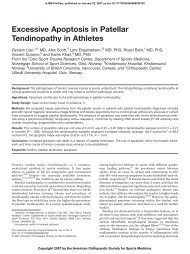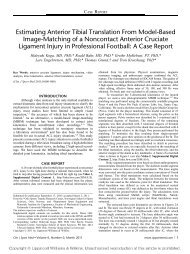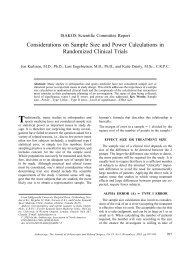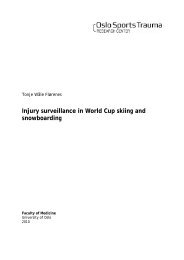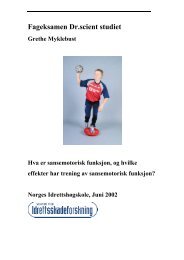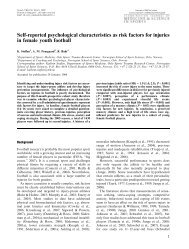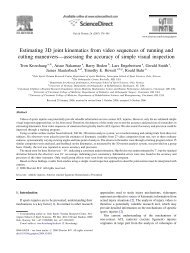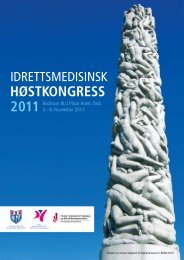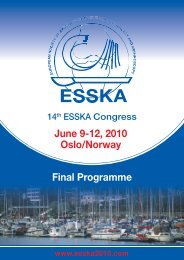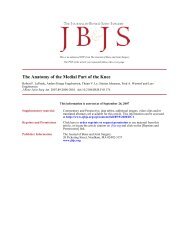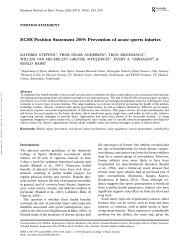Use of bisphosphonates for the treatment of stress fractures in athletes
Use of bisphosphonates for the treatment of stress fractures in athletes
Use of bisphosphonates for the treatment of stress fractures in athletes
You also want an ePaper? Increase the reach of your titles
YUMPU automatically turns print PDFs into web optimized ePapers that Google loves.
Knee Surg Sports Traumatol Arthroscbone is <strong>in</strong>active, at least as long as it rema<strong>in</strong>s sequestered<strong>the</strong>re [63]. In dog ribs treated with risedronate or alendronate<strong>for</strong> 1 year, alendronate has been shown to <strong>in</strong>hibitnormal microdamage repair that arises from a markedsuppression <strong>of</strong> bone remodel<strong>in</strong>g, which <strong>in</strong> turn results <strong>in</strong>accumulation <strong>of</strong> microdamage [2, 37, 46, 47]. Boneremodel<strong>in</strong>g decreased 53 and 68% as a result <strong>of</strong> risedronateor alendronate <strong>treatment</strong>s, while <strong>the</strong> correspond<strong>in</strong>g <strong>in</strong>crease<strong>in</strong> microcrack damage was 490 and 630%, respectively. Inaddition, <strong>the</strong> energy required to fracture <strong>the</strong> rib was significantlydecreased by 19% <strong>in</strong> <strong>the</strong> alendronate <strong>treatment</strong>group. While <strong>the</strong>se experiments used bisphophonate dosesseveral times higher than <strong>the</strong> equivalent doses <strong>for</strong> humanosteoporosis patients, it strongly suggests that boneremodel<strong>in</strong>g is necessary to prevent fatigue microdamagefrom accumulat<strong>in</strong>g and weaken<strong>in</strong>g <strong>the</strong> bone.Long-term use (5–10 years) <strong>of</strong> <strong>bisphosphonates</strong> <strong>for</strong>osteoporosis <strong>the</strong>rapy appears to be safe [11, 15]. However,<strong>the</strong>re is a case series [55] that revealed severe deficiencies<strong>in</strong> bone <strong>for</strong>mation <strong>in</strong> n<strong>in</strong>e patients on long-term alendronate<strong>the</strong>rapy (3–8 years). This resulted <strong>in</strong> an <strong>in</strong>creased susceptibilityto non-sp<strong>in</strong>al <strong>fractures</strong> that healed poorly. Inaddition, Ott [55] speculated that long-term alendronate<strong>treatment</strong> <strong>in</strong> humans might impair mechanical bonestrength. This suggestion was based on <strong>the</strong> apparent<strong>in</strong>crease <strong>in</strong> <strong>the</strong> rate <strong>of</strong> vertebral <strong>fractures</strong> with prolonged<strong>treatment</strong> [75], though refuted by <strong>the</strong> authors <strong>of</strong> that report[76]. The <strong>in</strong>duction <strong>of</strong> osteopetrotic-like lesions <strong>in</strong> a childtreated with extremely high doses <strong>of</strong> pamidronate has alsobeen reported [81]. Lenart et al. [36] recently showed thatlow-energy <strong>fractures</strong> <strong>of</strong> <strong>the</strong> femoral shaft with a simple,transverse pattern and hypertrophy <strong>of</strong> <strong>the</strong> diaphyseal cortexwere associated with alendronate use. They suggested thatthis may result from propagation <strong>of</strong> <strong>stress</strong> <strong>fractures</strong> whoserepair was retarded by dim<strong>in</strong>ished osteoclast activity andimpaired microdamage repair result<strong>in</strong>g from prolongeduse. Long-term suppression <strong>of</strong> bone remodel<strong>in</strong>g by bisphosphonatealso <strong>in</strong>creased non-enzymatic cross-l<strong>in</strong>k<strong>in</strong>gand could result <strong>in</strong> brittle bones [64, 68].Potential adverse effectsIt is always necessary to consider <strong>the</strong> risks and benefits<strong>of</strong> any prescribed medication. When treat<strong>in</strong>g a non-lifethreaten<strong>in</strong>g disease such as <strong>stress</strong> <strong>fractures</strong>, <strong>of</strong>f-label use <strong>of</strong>a drug demands special caution. In a case series us<strong>in</strong>g<strong>in</strong>travenous pamidronate <strong>for</strong> <strong>the</strong> <strong>treatment</strong> <strong>of</strong> <strong>stress</strong> <strong>fractures</strong>,<strong>the</strong> most common short-term side effects werenausea, fatigue, arthralgias, and myalgias [71]. All <strong>of</strong> <strong>the</strong>side effects resolved with<strong>in</strong> 24–48 h. S<strong>in</strong>ce nausea was <strong>the</strong>ma<strong>in</strong> problem with <strong>the</strong> 90 mg dose when compared with<strong>the</strong> 60 mg dose, <strong>the</strong> authors recommended us<strong>in</strong>g a 60 mg<strong>treatment</strong> dose. On <strong>the</strong> o<strong>the</strong>r hand, <strong>in</strong> a randomized controlledstudy <strong>of</strong> military recruits, risedronate use <strong>for</strong> <strong>the</strong>prevention <strong>of</strong> <strong>stress</strong> <strong>fractures</strong> had no more side effects thana placebo <strong>treatment</strong> [50].Oral <strong>bisphosphonates</strong> can result <strong>in</strong> stomach upset,<strong>in</strong>flammation, and erosions <strong>of</strong> <strong>the</strong> esophagus, which is <strong>the</strong>ma<strong>in</strong> problem <strong>of</strong> all oral nitrogen-conta<strong>in</strong><strong>in</strong>g preparations.This can be prevented by rema<strong>in</strong><strong>in</strong>g seated upright <strong>for</strong> 30–60 m<strong>in</strong> after tak<strong>in</strong>g <strong>the</strong> medication. A number <strong>of</strong> cases <strong>of</strong>severe bone, jo<strong>in</strong>t, or musculoskeletal pa<strong>in</strong> associated withoral <strong>bisphosphonates</strong>, alendronate and risedronate, havebeen reported [84]. These symptoms improved afterdiscont<strong>in</strong>uation <strong>of</strong> <strong>the</strong> drug <strong>treatment</strong>. Intravenousnitrogen-conta<strong>in</strong><strong>in</strong>g <strong>bisphosphonates</strong> can give undesirable<strong>in</strong>flammatory reactions, <strong>in</strong>clud<strong>in</strong>g an <strong>in</strong>crease <strong>in</strong> acutephaseprote<strong>in</strong>s, fever, flu-like symptoms, and ophthalmic<strong>in</strong>flammation, after <strong>the</strong> first <strong>in</strong>fusion [1, 43, 69, 73]. Theseare thought to occur because <strong>of</strong> <strong>the</strong>ir potential to activatehuman c,d-T cells [74]. Notably, <strong>the</strong>se symptoms do notrecur with subsequent <strong>in</strong>fusions. Some <strong>of</strong> <strong>the</strong> <strong>in</strong>travenous<strong>bisphosphonates</strong>, <strong>in</strong> particular zoledronic acid, have nephrotoxicpotential [14, 30].Recently, ano<strong>the</strong>r potential complication <strong>of</strong> <strong>the</strong>seagents has surfaced. Osteonecrosis <strong>of</strong> <strong>the</strong> jaw (ONJ)occurred <strong>in</strong> multiple myeloma or metastatic cancerpatients treated with <strong>in</strong>travenous <strong>bisphosphonates</strong> [10, 45,67]. These reports have led to a grow<strong>in</strong>g concern about<strong>the</strong> safety <strong>of</strong> oral <strong>bisphosphonates</strong> <strong>in</strong> patients with osteoporosis.In a literature review, Pazianas et al. [58]identified 26 cases <strong>of</strong> ONJ <strong>in</strong> patients receiv<strong>in</strong>g oral <strong>bisphosphonates</strong>.Consider<strong>in</strong>g that millions <strong>of</strong> patients havebeen prescribed <strong>bisphosphonates</strong> <strong>for</strong> <strong>the</strong> <strong>treatment</strong> <strong>of</strong>osteoporosis, this prevalence <strong>of</strong> ONJ was relatively low.The mandible was more commonly affected than <strong>the</strong>maxilla (2:1 ratio), and 60% <strong>of</strong> cases were preceded by adental surgical procedure [82]. The most common characteristics<strong>of</strong> those who developed ONJ were an ageC60 years (only one patient was aged \40 years), femalesex, and patients that had received previous <strong>in</strong>vasivedental <strong>treatment</strong> [58]. At present, <strong>the</strong>re is <strong>in</strong>sufficient dataavailable to construct evidence-based guidel<strong>in</strong>es <strong>for</strong> <strong>the</strong>prevention and <strong>the</strong>rapy <strong>of</strong> ONJ. In <strong>the</strong> case <strong>of</strong> adm<strong>in</strong>istration<strong>of</strong> <strong>bisphosphonates</strong> to <strong>athletes</strong>, a physician shouldcheck <strong>the</strong>ir previous dental history and current dentalcondition, and <strong>in</strong><strong>for</strong>m <strong>the</strong> patients about <strong>the</strong> low risk <strong>of</strong>develop<strong>in</strong>g ONJ, irrespective <strong>of</strong> <strong>the</strong> route and frequency<strong>of</strong> bisphosphonate adm<strong>in</strong>istration.Because <strong>of</strong> <strong>in</strong>creased sports participation <strong>in</strong> children andadolescents, <strong>athletes</strong> with open physis are predisposed to<strong>stress</strong> <strong>fractures</strong>. There are some concerns about <strong>the</strong> impact<strong>of</strong> <strong>bisphosphonates</strong> on open physis, chondro-osseousmodel<strong>in</strong>g, and consequent growth <strong>in</strong> o<strong>the</strong>rwise normal longbones. Smith et al. [70] showed that nitrogen-conta<strong>in</strong><strong>in</strong>g123




